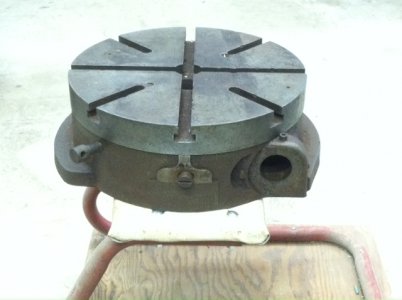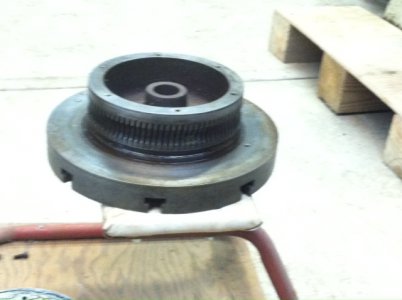I have a 12" rotary table. I would like to get it operational. It only (only is the BIG operational word) needs the drive worm and worm shaft. The table is in good shape for its age. It does not have a name plate on it so I do not know what brand it is. Economy is large factor, so I do not want to have the worm made. From looking at various worms available through a google search, the price is very reasonable if I can determine the correct one to get. Although the RT is larger than I need, it was given to me by a friend who has since passed away, which adds to my motivation to restore it to operation.
From what I can surmise I need to get a drive worm to match the RT driven worm gear, and then fabricate a shaft for the worm.
I looked in the machinery handbook, and in an old Boston Gear catalog for information on worm gears, and realized that it was way, way over my understanding. From the information given/needed for the gears and the formula's to derive them I was totally lost. I believe to be able to look up or order a worm, I need to know the gear "throat" diameter, lead angle, and the axial, circular, and diametrical pitches. I might as well be trying to decipher a foreign language.
I have attached pictures of the RT, the RT top, and a sketch (not to scale) of the RT dimensions. The hole for the worm shaft is 1.5". The threads are right handed. The number of teeth is 90. Measuring the angle of the teeth at 86 degrees, the tooth angle should be 4 degrees. On the sketch, I have attempted to sketch the tooth width as well.
I am hoping someone can point me in the right direction as to the gear I need or from the dimensions I have can give me the above so I can try and order the necessary worm. If any other dimensions are needed, I would be happy to attempt to get them. Thanks in advance for your help.
doug


From what I can surmise I need to get a drive worm to match the RT driven worm gear, and then fabricate a shaft for the worm.
I looked in the machinery handbook, and in an old Boston Gear catalog for information on worm gears, and realized that it was way, way over my understanding. From the information given/needed for the gears and the formula's to derive them I was totally lost. I believe to be able to look up or order a worm, I need to know the gear "throat" diameter, lead angle, and the axial, circular, and diametrical pitches. I might as well be trying to decipher a foreign language.
I have attached pictures of the RT, the RT top, and a sketch (not to scale) of the RT dimensions. The hole for the worm shaft is 1.5". The threads are right handed. The number of teeth is 90. Measuring the angle of the teeth at 86 degrees, the tooth angle should be 4 degrees. On the sketch, I have attempted to sketch the tooth width as well.
I am hoping someone can point me in the right direction as to the gear I need or from the dimensions I have can give me the above so I can try and order the necessary worm. If any other dimensions are needed, I would be happy to attempt to get them. Thanks in advance for your help.
doug



